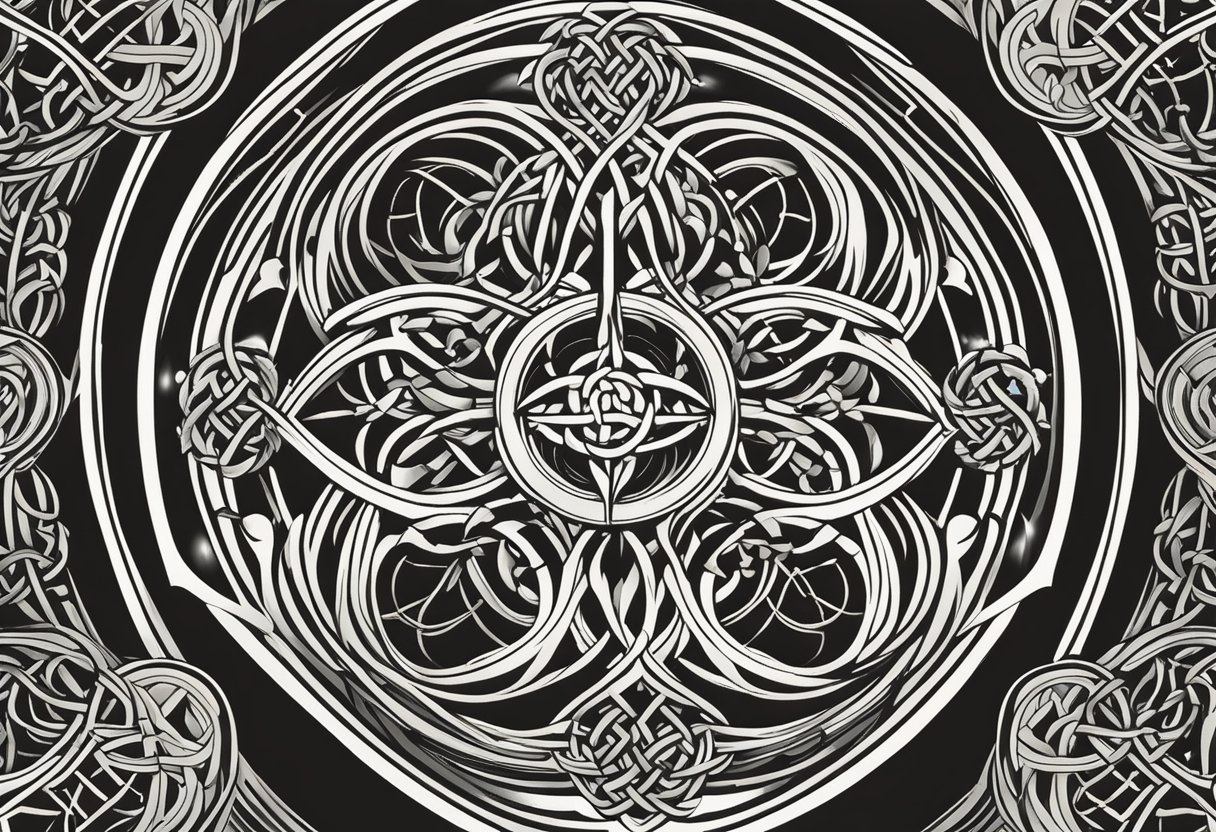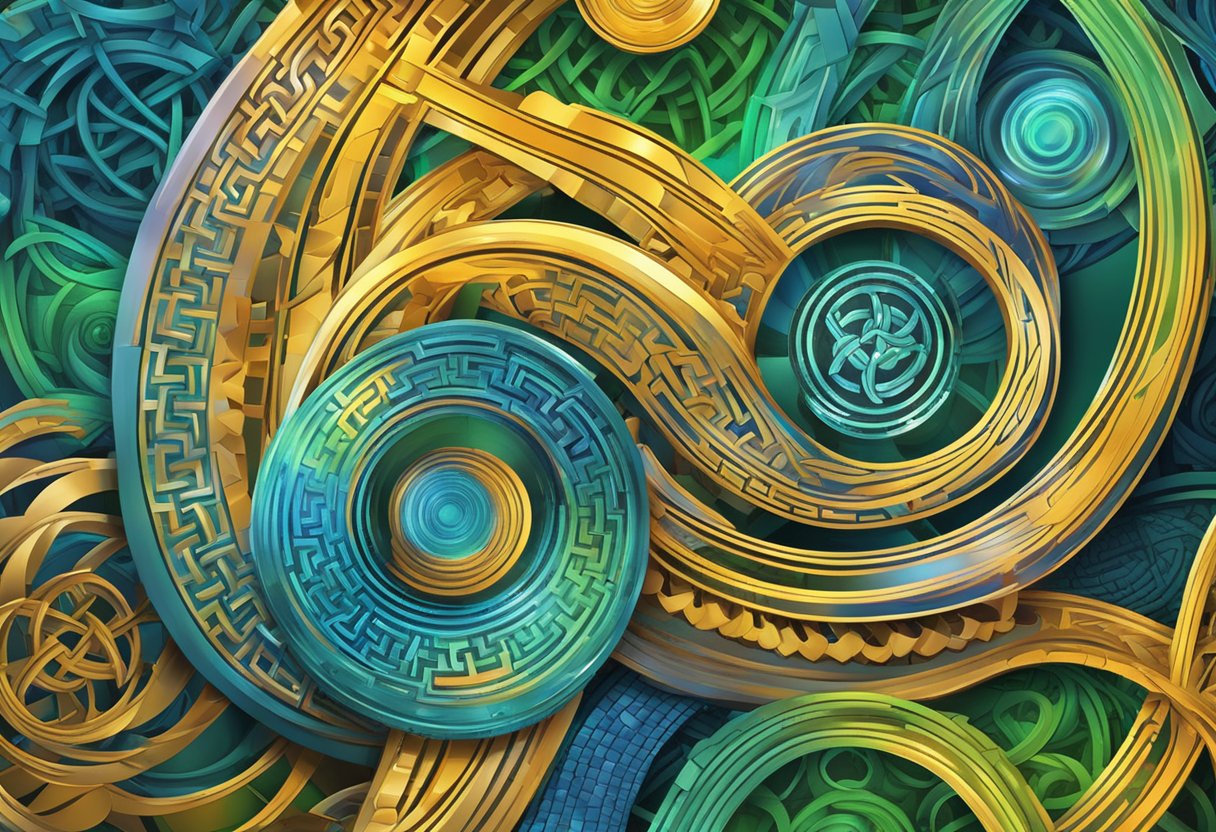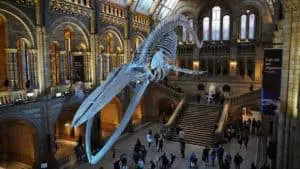Ancient Celtic Art Forms: Unveiling Historical Aesthetics

Updated On: April 07, 2024 by Noha Basiouny
Ancient Celtic art is a distinctive and complex tradition that emerged thousands of years ago amongst the Celtic tribes of Europe. Characterised by intricate patterns and symbolism, it provides a unique insight into the cultural and religious life of the ancient Celts. This art form spanned a variety of mediums, including metalwork, ceramics, textiles, and sculpture, each adorned with the Celts’ iconic spirals, knotwork, and zoomorphic motifs.
The Celts were skilled artisans who not only pursued beauty in their creations but also infused them with significant symbolic meaning. Their artwork, which evolved and spread across Europe, often depicts stylised human figures, animals, and mythical beings, suggesting a rich tapestry of folklore and belief. From the Hallstatt culture of the early Iron Age to the La Tène period, Celtic art forms reveal both an enduring legacy and sophisticated aesthetic sensibilities that have come to be closely associated with Celtic identity.
Table of Contents
Historical Context
In exploring the intricacies of Ancient Celtic art, we are primarily concerned with the artefacts and stylistic developments that emerged during the Iron Age in Central Europe. This period of artistic expression is deeply intertwined with the cultural influences and evolving interactions that Celtic societies had with neighbouring civilisations.
Origins and Evolution
Celtic art originated in Central Europe during the Iron Age, with its development often categorised into distinctive periods. The Hallstatt Period, named after a site in Austria, represents the early phase of Celtic art, spanning from around 800 to 500 BCE. This era is characterised by its geometric designs and abstract representations of animals and humans, rendered on metalwork, pottery, and other materials.
The succeeding La Tène Period, approximately from the 5th to the 1st centuries BCE, saw a flourishing and evolution of Celtic art. A significant transition is observed from the geometric patterns of the Hallstatt culture to the more intricate and elaborate designs of the La Tène style. This period is marked by highly stylised and sophisticated motifs, including spirals, triskeles, and knotwork, which are often found on weaponry, jewellery, and other metalwork.
Influence of Other Cultures
Celtic art was not developed in isolation but was significantly influenced by interactions with neighbouring cultures. The Etruscans, renowned for their metalworking, left a lasting impact on Celtic artisans, shaping the complexity of their designs and the techniques employed. The art of the Romans also left an imprint on Celtic art, with the incorporation of more naturalistic forms and the adoption of Roman motifs and styles becoming increasingly evident following the Roman conquest of Celtic lands.
As we examine these historical contexts and the tangible remnants of Celtic societies, it’s evident that the evolution of Celtic art is a rich tapestry, woven from indigenous traditions and external inspirations alike. The enduring allure of these works lies not only in their aesthetic appeal but also in their capacity to offer us insights into the past civilisations that created them.
Materials and Techniques

In the realm of ancient Celtic art, we observe a sophisticated use of materials and prowess in various techniques. From exquisite metalwork to intricate stone carvings, the Celts left an indelible mark on art history.
Metalworking Skills
The Celts were adept in working with a variety of metals, including iron, bronze, gold, silver, and copper. Their metalwork often involved creating intricate patterns and designs. Notable methods included hammering, casting, and engraving to produce jewellery, weaponry, and intricate brooches.
- Manufacture: Items were commonly made by casting, where molten metal is poured into a mould.
- Iron: Used primarily for weaponry and tools.
- Gold & Silver: Favoured for high-status decorative objects like torcs and cloak pins.
Use of Enamel and Glass
Another aspect of their artistic craftsmanship was the use of enamel and glass to add colour and detail to their metalwork.
- Enamel: Applied as a powder and then heated to create a glossy finish.
- Glass: Crafted into beads and inlays, complementing the metal’s sheen.
Stone and Wood Arts
Finally, the Celts were also masters of carving stone and wood, leaving behind monumental stones and wooden artefacts that display a similar complexity of design.
- Stone: Used for erecting structures and carving cross slabs, featuring intricate knotwork.
- Wood: Though fewer pieces survived, it was used extensively in everyday items, often decorated with patterns echoing metal artefacts.
Through these materials and techniques, the tapestry of Celtic artistry was woven into an array of functional and ceremonial objects, each embodying the aesthetic flair of its creators.
Key Motifs and Symbolism
Ancient Celtic art is renowned for its distinctive motifs and symbolism, deeply intertwined with the culture and beliefs of the Celts. In this section, we explore the most prevalent themes featured in their artistic expressions.
Animal Representation
The Celts depicted various animals in their artwork as symbols of both the natural and the supernatural worlds. Birds, frequently seen in Celtic art, represented freedom and transcendence. The horse, a recurring subject, was associated with warfare and sovereignty. These animals were not just ornamentation; they were imbued with significant meaning and reflected the Celts’ deep reverence for the natural world.
Nature and Spirals
Nature was a central element in Celtic art, often expressed through spirals and other organic shapes. The spiral, considered a sacred symbol, represented eternal life and the flux of the natural world. The Celts believed in the interconnectedness of all life, a concept often visualised through the Celtic Tree of Life, with its branches reaching for the heavens and roots delving into the earth for balance and harmony.
Geometric Patterns
Geometric patterns in Celtic art are hallmarks of their design, boasting intricate symmetry and knotwork. These designs were not random; they were carefully crafted to embody the Celts’ understanding of the universe. Key patterns, composed of interlocking lines, symbolised life’s complexity, while knotwork, with no clear beginning or end, signified the intertwining of the physical and spiritual realms. The sensitive use of geometric design captures the Celts’ deep fascination with order, continuity, and the cyclical nature of existence.
Iconic Celtic Artwork
Celtic art is distinguished by its intricate designs, craftsmanship, and symbolic depth. In examining its most iconic artworks, we uncover masterpieces of metalwork and stone carvings that have captivated both historians and art enthusiasts alike.
Renowned Metalwork
A prominent feature of Celtic art is its exquisite metalwork. Torcs, elaborate neck rings typically made from gold or bronze, serve as a testament to the Celts’ advanced metallurgical skills. They were not merely decorative but also held significant social prestige. One iconic example is the Snettisham Torc, a masterpiece of Iron Age artistry found in Norfolk and now on display at the British Museum.
Celtic warriors also carried beautifully decorated swords, and their sword style often featured intricate patterns and design elements that elevated these weapons to artistic marvels. The Battersea Shield, dredged from the River Thames, exhibits the La Tène style’s characteristic swirling designs in metal. This shield, while likely used for ceremonial purposes, exemplifies the height of Celtic art in metal.
The Tara Brooch is another striking piece of Celtic metalwork from around 700 AD. This brooch is noted for its sophisticated design and the immense skill required in its creation. Decorated with fine filigree and intricate interlaced patterns, it is often considered one of Ireland’s greatest treasures and a pinnacle of early medieval craftsmanship in metal.
Famous Stone Carvings
Celtic stone carvings offer us durable records of the Celts’ artistic expression. The remaining sculptures and reliefs provide valuable insights into the culture and iconography of the Celtic people. Stone crosses and slabs, often found throughout the British Isles and Ireland, are adorned with typical Celtic motifs such as knotwork and spirals.
One of the most iconic examples of these carvings can be seen on the high crosses found throughout Ireland. These freestanding crosses, often reaching impressive heights, are intricately carved with Biblical scenes and Celtic designs, bridging the pagan Celtic and Christian traditions in their imagery.
In all, whether it be the regal jewellery passed down by Celtic chieftains or the imposing sculptures standing guard over ancient sites, these iconic works of art continue to impress us with their beauty and complexity, and serve as enduring symbols of the rich Celtic heritage.
Religious and Mythological Themes
In examining Ancient Celtic art, we find a deep intertwining of religious significance and mythological storytelling. The art is reflective of cultural beliefs and the important transition from Pagan origins to Christian influences.
Pagan Traditions
Celtic art is renowned for its intricate designs and symbolic motifs that are strongly rooted in Pagan traditions. The Celts expressed their spiritual connection to nature through depictions of enigmatic deities, often represented in powerful warrior forms. Their art was not merely decorative but imbued with religious significance, seen on everything from pottery to shields. Common aspects of these designs also included animals and vegetal motifs, symbolising various attributes and powers, a concept carried forward from their belief in the sanctity of the natural world.
Christian Integrations
With the advent of Christianity, previously Pagan symbols were combined with Christian themes, leading to a unique amalgamation visible in transcendent Celtic Art. This is most spectacularly expressed in the creation of Illuminated Manuscripts, like the Book of Kells. This masterful piece of art showcases the integration of Christian iconography with Celtic motifs, resulting in complex knotwork and interlace patterns that both beautify script and imbue the text with a divine essence. It reflects our ability to retain cultural identity whilst adapting to new beliefs.
Social and Political Influence

Celtic art is not merely decorative; it reflects intricate social structures and political power within ancient communities. It bears the hallmarks of cultural identity, regional diversity, and the interplay of trade and warfare.
Celtic Life and Hierarchies
In Celtic society, the intricate patterns of art and artefacts reveal a clear stratification of class and occupation. The rich cultural tapestry of regions, such as Gaul and the British Isles, was expressed through objects signifying rank— from the weapons of warriors to the torcs signifying nobility.
Art as a Status Symbol
Art served as a tangible statement of power and prestige. The elite would be buried with elaborately decorated swords and scabbards, horse trappings, and jewellery. Trade links spread the influence of regional styles, while the graves of the high-born outshone those of ordinary people, clearly marking the social order in death as they had done in life.
Technological Advances in Artistry
As we explore ancient Celtic art, it’s essential to recognise the technological strides in materials and design which underpinned the creation of such intricate works. Their craftsmanship is not solely an aesthetic feat but also a testament to their innovation and ingenuity with materials like metals.
Innovation in Metal Alloys
Ancient Celts were proficient in utilising a variety of metals for their artistry. Advances in metalwork, particularly with iron, bronze, and copper, were instrumental in the creation of durable and detailed pieces. Iron was the preferred medium for tools and weaponry, owing to its strength and availability. The combination of copper with tin created bronze, a material that revolutionised their artistic capabilities, enabling more intricate and expansive sculptures. Manufacture techniques improved over time, allowing the Celts to produce high-quality, sophisticated metal artefacts with greater efficiency.
Developments in Artefact Design
Our artistic ancestors exhibited a transformative approach to the creation of objects, highlighting advancements not only in manufacture but also in design. The robustness of metal allowed for the production of ornate sculpture without the fragility that characterises clay or stone work. Celtic artefact design evolved with their technical prowess, leading to the development of remarkably detailed designs, which included the iconic spirals and interlacing patterns. These patterns were not only aesthetically pleasing but also showcased the high level of sophistication in Celtic craftsmanship.
Cross-Cultural Exchanges

The ancient Celtic world was a hub of artistic and cultural interactions facilitated by trade and contact with neighbouring civilisations. These exchanges left a significant imprint on Celtic art, which can be seen in the adoption of foreign styles and motifs.
Trade and Artistic Exchange
Trade was a fundamental aspect of the Celtic economy, connecting us with the broader European and Mediterranean worlds. Goods such as wine, pottery, and metals were traded extensively with the Romans, Greeks, and Etruscans, leading to a fusion of artistic techniques and styles. In Britain and Ireland, for example, one can discern the stylistic influences of Mediterranean art in Celtic metalwork – the intricate designs of which often incorporated elements not native to the Celtic artistic vocabulary.
Influences Beyond the Celtic World
Our impacts went beyond our immediate geography, reaching into the realms of the Roman Empire and beyond. The Celts interacted with the Thracians and the Scythians, as well as with the Germanic tribes of central Europe, including regions of what is today known as France and Germany. The La Tène style, characterised by its elegant curvilinear motifs, is one such example of Celtic art that resonated across these boundaries. This style not only reflected our aesthetics but also became a marker of Celtic identity as it spread throughout Europe.
Celtic Art in Modern Media

In this section, we detail how Celtic art continues to influence various forms of modern media, extending its legacy from the past into the present. These influences are evident in contemporary artistic expressions and educational resources, allowing for renewed appreciation and study.
Contemporary Representations
Celtic art’s intricate patterns and iconic designs have survived through time, finding new life in today’s creative mediums. The Celtic Revival movement has spurred artists to integrate this ancient style into modern artworks, including digital creations, tattoos, and even cinema. These reimagined motifs keep the essence of Celtic culture alive, blending traditional aesthetics with contemporary methods. Paintings, for example, often feature interlacing knotwork and spirals that are definitive of Celtic art, revealing how historic styles can inform and inspire modern visual arts.
Celtic Art in Education
Educational mediums have embraced Celtic art, recognising its historical significance. Through various media platforms, including documentary films and interactive websites like Connolly Cove, the art form is meticulously explored and introduced to new audiences. These resources often highlight the cultural and historical contexts in which Celtic art was created, offering a comprehensive understanding beyond mere aesthetics. Educators and students alike benefit from such media, as they provide valuable insights into the artistry and symbolism of the ancient Celts in relation to our contemporary world.
Preservation and Legacy

The safeguarding of Ancient Celtic art ensures its continued influence on future generations, embedding a rich cultural heritage within modern society. It’s our responsibility to preserve the intricate beauty of works like the Tara Brooch and the dynamic expression found in Celtic sculpture, ensuring they endure for years to come.
Conservation Efforts
Efforts to conserve Celtic art involve meticulous restoration and preventive care undertaken by cultural heritage professionals. Museums play a crucial role in these endeavours, leveraging advanced techniques to prevent deterioration. For instance, controlled environments are maintained to protect delicate items from environmental factors.
- Preventive Conservation: Regular monitoring and climate control to prevent damage
- Restorative Intervention: Careful restoration of items like the Tara Brooch to their former glory
- Documentation and Research: Detailed records of Celtic styles and materials for educational purposes
Influence on Future Generations
The impact of the Ancient Celts on contemporary culture is substantial, thanks in part to the Celtic Revival that reignited interest in these traditional styles. The legacy left by Celtic art forms is preserved not only in physical artefacts but also through education and cultural appreciation.
- Cultural Heritage: Integration of Celtic designs in modern artefacts, showcasing historical continuity
- Museums: Exhibitions and interactive displays that educate the public on the intricacies of Celtic art
- Education: Academic curricula and books on the subject, fostering an appreciation for this ancient art form among new audiences
Frequently Asked Questions

In this section, we address common inquiries regarding the distinct and enduring art forms of the ancient Celts, shedding light on materials, motifs, classic works, and cultural influences.
What materials were typically utilised in ancient Celtic artworks?
The Celts frequently used materials such as metal, especially bronze and gold, for their intricate jewellery and weaponry. Wood and stone were also favoured for sculptural and monumental works, carrying an array of symbolic carvings.
Which motifs are commonly found in Celtic artistic designs?
Artistic designs in Celtic artwork are renowned for their complex interlacing patterns, spirals, knotwork, and zoomorphic elements. These motifs hold significant meaning and are often found in manuscripts, metalwork, and stonework.
Can you provide some classic examples of Celtic art?
Classic examples of Celtic art include the Muiredach’s High Cross, a magnificently carved stone cross, and the Battersea Shield, noted for its exquisite metalwork. These works exemplify the high level of craftsmanship that is characteristic of Celtic art.
How does La Tène art reflect the aesthetics of the Celts?
La Tène art, named after the archaeological site in Switzerland, reflects the aesthetics of the Celts through its stylised and intricate designs, which include plant motifs and vividly abstract human and animal forms.
In what ways does modern Celtic art maintain continuity with ancient traditions?
Modern Celtic art maintains continuity with ancient traditions through the preservation of the/Celtic_Art_-_Cultural_Artifacts_of_the_Ancient_Celts”>distinctive motifs] and techniques, such as knotwork and spirals, which are still used in various contemporary artefacts and designs.
How does Celtic art distinguish itself from Roman artistic traditions?
Celtic art is easily distinguished from Roman artistic traditions by its use of complex geometric patterns and stylised zoomorphic decorations. Unlike the more figurative style of Roman art, Celtic designs favour symbolism and abstraction.






